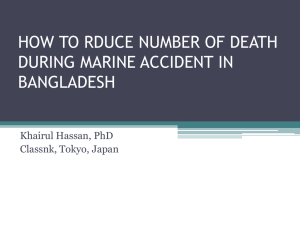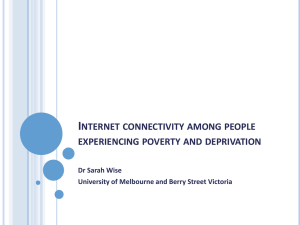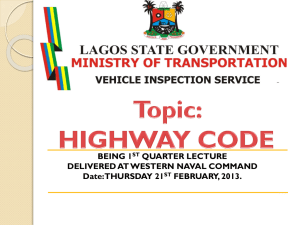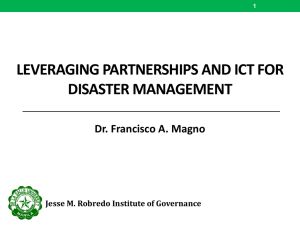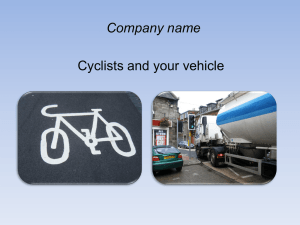Introduction to road user safety in the UK
advertisement
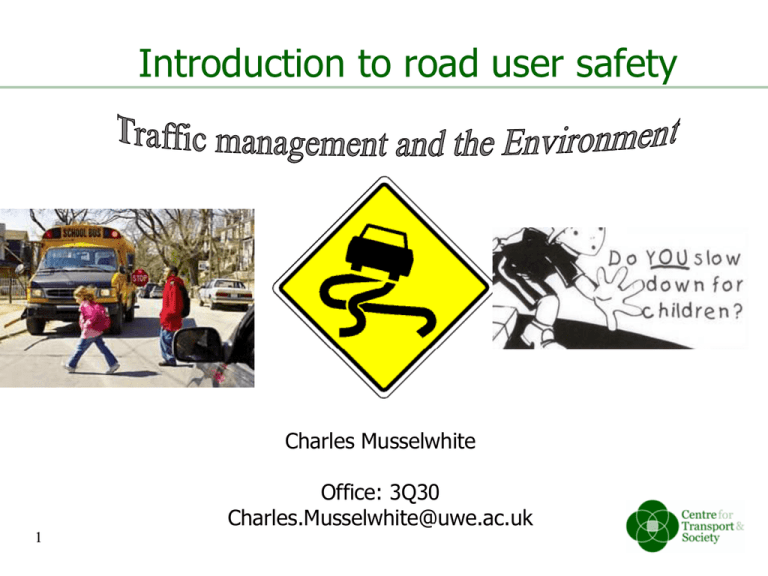
Introduction to road user safety Charles Musselwhite Office: 3Q30 Charles.Musselwhite@uwe.ac.uk 1 Content UK statistics on road user safety – – – – – – – – – Annual accidents Over time By mode Gender and age Older People Children Black and minority ethnic groups Areas of high deprivation Compared with EU Collecting data: STATS 19 What STATS19 can tell us additionally – Causal factors 2 3. Road traffic injuries and death In 2011 the Road Casualties in Great Britain Annual Report states: There were a total of 203,950 casualties of all severities, – 2 per cent lower than in 2010. – 17 per cent lower than 2005-9 average 1,901 people killed – 3 per cent increase from 2010, – 32 per cent decrease from 2005-9 average 23,122 were seriously injured – Up 2 per cent on 2010 and – Down 15% from 2005-9 average 178,927 were slightly injured 3 – down 3 per cent on 2010. – Down 17% from 2005-9 average By mode 4 Compared to traffic 5 6 7 By mode 8 9 Motorcycling road user safety Motorcycles = 20% of deaths, 1% of traffic Non-built up roads and larger bikes esp. the problem. 10 Road user casualties by age 11 Road user safety and age and gender AGE DIFFERENCES The 16-29 age group accounts for over a third of all deaths on the roads nearly 30% of all road deaths and serious injuries involve a young driver. In fact more than 3 young drivers a day are seriously injured or killed on the road – that amounts to 1,200 a year. 1 in 5 drivers crash in their first year of driving, and 1 in 3 young male drivers will write off a car in their first year of driving. The graph shows the much greater crash rate of young drivers, especially males aged 16-19 years, compared with other age groups. 12 Older people and driving 13 Older people and driving Slight increase in risk per mile driven Still an increase in at-blame accidents Older drivers are over represented in accidents: And mention having problems with: – – – – – – – – – – 14 Frailty Stereotype/attribution error • • • • at Junctions; in merging traffic; with right-hand turns (when driving on the right-hand side of the road) and; in busy traffic (see Clarke et al., 2009 for review) • increased fatigue; • poorer reactions (for example, on average, drivers over 55 take 22% longer to react than drivers under the age of 30 years) (DfT, 2001); • difficulty with glare and luminance (average recovery time from glare, from lights from other vehicles or low sun for example, at age 16 is 2 seconds whereas at age 65 is 9 seconds and 75 year old driver requires 32 times the brightness to be able to see the same scene they did at age 25) (DfT, 2001) and; • difficulty keeping a consistent constant speed (difficulty in detecting changes in feedback from the vehicle speed and difficulty in keeping foot pressed to the floor in the same position for long periods of time) (Musselwhite and Haddad, 2010a). Older people and driving 15 Langford et al. (2006) suggest that low mileage drivers entirely make-up the increase in killed or serious accidents post 75 years of age. Keeping driving, maintains skill practice and performance Higher miles = more likely to drive on motorways or dual carriageways, the safer routes. Self-selecting? Older People and pedestrian road user safety In the UK, there is a rise in the pedestrian accidents from late middle age, despite older people travel less than younger people (Dunbar, et al., 2004). Although pedestrians aged 60 or above represent only 20.5% of the population, they account for 47% of pedestrian fatalities (Hakamies-Blomqvist, 2003). – – More likely to walk Frailty The combination of physiological/cognitive/psychological aspects together with the socio-economic aspects of these group (low car ownership/use, accessibility needs etc.) expose elderly people to higher road accident risk. Beatty and Parker (2007) identified the two biggest problems for older pedestrians as: – the poor condition of the pavement (uneven or slippery) and – the speed, volume and type of traffic. – In addition, difficulties crossing roads due to lack of safe crossings or lack of time to cross and the problem of pavements blocked by parked cars, bushes and other obstructions were also major problems 16 Children 17 Children 18 Children and road accidents Around 5,000 children under the age of 16 die or are seriously injured on Britain's roads each year Nearly two in three road accidents happen when children are walking or playing Almost two-thirds of child accident victims are boys As a child gets older the risk of a road accident increases A child from a low-income family is five times more likely than a child from a high-income family to be killed on the road Children from an ethnic minority are involved in up to twice as many accidents while walking or playing as the national average The risk of being involved in a road accident when walking or playing is more than 10 times greater for a child with hearing difficulties 19 The number of children killed and seriously injured on the roads has declined steadily for many years. Black and Minority Ethnic Groups • Traffic accident studies have found significant differences in accident risk rates based on ethnicity (see White et al., 2000). • A review of road user accidents amongst ethnic minorities in a variety of countries, including United States, Sweden, Israel, Singapore and New Zealand, suggests children of ethnic minority background do suffer substantially increased risk of pedestrian injury relative to the norms for the country as a whole (Thomson and Tolmie, 2001). • In the UK, children of Asian ethnic origin appear to be disproportionately vulnerable (Kimberlee and Towner, 2007). • As White et al. (2000) suggests - per head of population, those young pedestrians of Asian origin aged 0-9 years were over-represented in road accidents by a factor of 2. Further research into ethnicity and road user safety is obviously required. 20 Road user safety and deprivation Noland & Quddus, 2004 reports the positive correlation between area deprivation and traffic casualties. Their results show that areas that have higher IMD (Index of Multiple Deprivation)[ scores (i.e., are more deprived) are associated with increased serious and slight injuries from road traffic accidents. Grayling et al. (2002) also addressed the relationship of different aspects of deprivation on adult and child pedestrian casualties and concluded: Income, health and education deprivation was strongly associated with more child pedestrian casualties and less strongly associated with more adult pedestrian casualties Housing deprivation is strongly associated with both more child and more adult casualties. Employment deprivation is strongly associated with fewer child pedestrian casualties but more adult pedestrian casualties. This is explained by the notion that in areas of high unemployment there would be less traffic but unemployed adults might spend more time as active pedestrians. Accessibility deprivation is associated with fewer child and adult pedestrian casualties, which is explained by the notion that there is likely to be more traffic and pedestrian activity in areas where there are more shops and services accessible. 21 By road type 22 EU and road user safety 23 24 UK and Europe pedestrian deaths 25 UK and Europe child pedestrian deaths 26 Capturing the data: STATS19 -Data does not match very well to hospital admissions (33% the same!) -Does not capture all slight casualties -Subjective statements -Comprehensive, consistent reporting system 27 28 29 30 Contributory factor 31 32 33 34 Driver error is crucial 35 14% of all deaths result from vehicle travelling too fast 4% of all accidents involve alcohol – 121 deaths (7%) Using mobile phone – 21 deaths (2%) Causes of accidents and road type 36 Causes of accidents by vehicle type 37 Causes of accident by vehicle type 38 Road casualty causation ROAD USER (95%) Skill SKILLS – Experience and development – Training Attitude ATTITUDES – Norms and peer pressure – Education, enforcement ROAD ENVIRONMENT Infrastructure – Engineering 39 Conclusion Casualty reduction improvements year on year Key problems remain: – – – – – children pedestrian accidents Younger drivers Motorcyclist deaths Deprivation Rural areas Data collected by STATS19 form Driver error is key to problem – Skills – Attitude Solutions? 40 Reference DfT (2012)., Reported Road Casualties 2011. Available via https://www.gov.uk/government/pub lications/reported-road-casualtiesgreat-britain-main-results-2011
